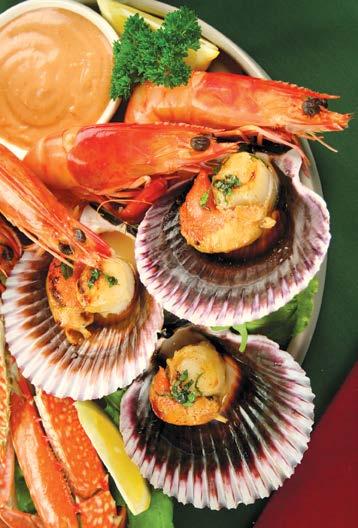
10 minute read
SUSTAINABLE SHELLFISH
SUPERFOOD OF THE SEA
by April Thompson
Advertisement
jabiru/AdobeStock.com T he perfect food may not be underfoot, but rather, underwater. It’s delicious, fast-growing, nutritionally dense, sustainably produced, locally available from coast to coast and comes in nature’s own sturdy packaging. “Shellfish is the most sustainable protein on the planet. There are no antibiotics, no pesticides, no fertilizer and no feed needed to raise shellfish,” says Bob Rheault, executive director of the East Coast Shellfish Growers Association, which represents 1,500 shellfish farmers from Maine to Florida.
Shellfish is a nutritional powerhouse, providing proteins, essential amino acids, long-chain polyunsaturated fats, vitamins and carotenoids. The drastically shorter life cycle of shellfish compared to other farmed seafood also means shellfish producers can generate more food more quickly.
Shellfish also offer many ecological benefits; they filter the water, remove excess nutrients and create habitat for juvenile fish, Rheault says. A single oyster can filter up to 50 gallons of water per day, according to the Oyster Recovery Partnership, an organization that restores reefs in conjunction with a shell recycling network of restaurants and public drop sites across the mid-Atlantic region.
Ray Hilborn, a biologist and professor at the University of Washington School of Aquatic and Fishery Sciences, in Seattle, has compared the relative environmental costs of different food sources, including grains, poultry and imitation, plant-based meats. He has found that farmed shellfish, specifically mollusks like oysters, clams and mussels, provide the lowest impact protein of them all. “Shellfish has a very low carbon footprint and enormous yield per area,” he
says. “Mussel farms, for example, are pretty much just ropes hung from rafts, with no changes to the ecosystem or loss of biodiversity, as compared to agriculture.”
Bivalve shellfish like clams and oysters are mainly sourced from farms because wild stocks are largely depleted due to overharvesting, habitat loss and other contributing factors. “Somewhere around 90 percent of mussels and oysters on the market are farmed,” Rheault says. “If you see perfect-looking oysters at the raw bar, you know they are farmed. Out of the wild, they can look gnarly.”
Restorative aquaculture, which produces seafood using scientific principles that enhance coastal environments, may be one of the best opportunities to restore ecosystems while feeding the Earth’s growing population, according to a report from The Nature Conservancy. However, Hilborn points to “the impact of food, not just how it’s grown, but how it got to you.” Processed shellfish has a bigger carbon footprint, so it’s ecologically desirable to look for fresh, local options whenever possible.
Local production has a culinary benefit, too. “Every waterway has its own unique ‘merroir’, or flavor, that comes from the local environment. The differing levels of salinity and minerality, among other things, can lead to a very different flavor,” adds Rheault. While there is only one dominant species of oyster on the East Coast, there are three varieties found on the West Coast and dozens more around the world, each with different flavor profiles, according to Rheault; oysters also have differing flavors throughout the year. “Fall oysters have a rich, full flavor; they can be skinny in the spring. I like them in winter best of all.”
Perry Raso, owner of the Matunuck Oyster Bar and Farm, in Wakefield, Rhode Island, and a leader in the growing shellfish farming industry, grew up digging littleneck clams as a youngster. He earned a graduate degree in aquaculture before launching and growing a multifaceted business, including a restaurant, a seven-acre oyster farm and an organic vegetable farm. He raises and sells more than 1 million mature oysters a year and also supplies 5 million seed oysters to other aqua farmers.
Voted one of the top 20 seafood restaurants in the country by Time Out, Matunuck Oyster Bar serves several shellfish delicacies, including a classic oyster stew made with rosemary broth, scallop ceviche, quinoa crab salad and oysters on the half shell with a cucumber passionfruit gazpacho. The menu also features “vegan scallops” made from seared king oyster mushrooms.
Rheault’s favorite way to eat an oyster, though, is simply with two drops of lime. “The lime knocks out your salt receptors and allows you to really taste the other flavors,” he says. “Grilling is another great way to introduce people to oysters. You don’t even need to shuck them; the grilling firms up the meat.”
Connect with Washington, D.C., freelance writer April Thompson at AprilWrites.com.
Fresh, Local Seafood ‘On The Go’
Shrimp On The Go is locally owned and operated with a store in Foley and appearing inside the Coastal Farmers & Fishermens Market every Saturday. All wild-caught selections include Louisiana crawfish (in season), crabmeat, fresh oysters (from Bon Secour), clams, scallops, mussels, royal reds, salmon, Alabama coastal fish like snapper, grouper and trigger fish, along with cobia, mahi mahi, sushi grade yellowfin tuna, flounder, tilapia, swordfish, catfish and redfish.
Shrimp On The Go also offers meals for one or more, raw or steamed. There is housemade gumbo every Friday, stuffed crabs, shrimp stuffed potatoes, three different flavors of hushpuppies and crab stuffed jalapeño poppers. The newest and really popular specialty is twice baked shrimp stuffed potatoes. Delivery is also available.
“We stress freshness and consistency. Customer service is top-notch because we are family owned and we do our jobs with love,” says Chase Martinez, owner.
“My mom always says when things are meant to be, they’ll be. That’s why we are Baldwin’s Best #1 Seafood market in Baldwin County this year, 2022. We had the vision many years ago about setting up shop in this area and now we have almost outgrown our location since 2016,” says Martinez. Indeed, the business has expanded from offering only raw seafood and now has many varieties of local fish and other seafood specialty items, including meals to go.
Location: Shrimp on the Go Seafood Market, 20733 Miflin Rd., Ste C, Foley, AL (at Coastal Alabama Farmers & Fishermens Market). Facebook.com/ShrimpOTG. Contact ShrimpOTG@gmail.com.
VEGAN SHELLFISH ALTERNATIVES

Vegans or people with shellfish allergies can still enjoy the rich umami flavor of an oyster or clam with a little creativity. Here are a few suggested alternatives.
King oyster mushrooms:
This mushroom is a misnomer perhaps, as its meaty stem, sliced in one-inch sections and sautéed or broiled, looks and tastes more like a scallop than an oyster. In general, mushrooms have a similar mouthfeel to shellfish: The chitin found in the shells of crustaceans are also a key compound in fungi. They can be added to many dishes as a satisfying substitute for seafood and other animal proteins. However, shellfish and mushroom allergies can overlap as a result of chitin sensitivities, so allergy sufferers should proceed with caution. Seaweed: Kelp, dulse and other edible algae can also add a touch of that salty, sea-kissed flavor of shellfish, as well as important trace minerals and antioxidants, to dishes like chowders and stews without adding empty calories. Heart of palm: The tender chewy texture of hearts of palm, flavored well, can serve as a surprising proxy for shellfish and seafood, particularly for rich dishes like fried calamari, lobster rolls or crab salad.
For those seeking a plantbased diet for ethical or other reasons, it’s worth noting that a subset of vegans believe that consuming oysters and mussels does not contradict their commitment to a compassionate diet, given that bivalves lack a central nervous system. This somewhat controversial offshoot of veganism even has its own name—ostroveganism, from the Latin word ostrea, meaning oyster. Oysters, freshly shucked
BASIL VINAIGRETTE:
2 cups basil 1 small shallot 1 clove of garlic Dash of red pepper flakes ⅔ cup of olive oil 4 Tbsp champagne or red wine vinegar In a blender, combine and process the basil vinaigrette ingredients. Top freshly shucked oysters with a dash of the vinaigrette and place on the grill for 5 minutes at medium-high heat. Before removing them from the grill, sprinkle on some grated pecorino Romano cheese. Source: Deja Knight McMillan
SAUTÉED MUSSELS
4 cups mussels ½ oz extra-virgin olive oil 1 oz chopped yellow onion 1 oz chopped fresh garlic 1 oz white wine 1 oz Pernod (licorice liqueur) Juice of one freshly squeezed, whole lemon 1 oz chopped, fresh basil Heat the oil in sauté pan. Add mussels and dome with a second sauté pan. Once all mussels have opened, add the onions and garlic. Cook until onions are translucent. Add white wine and bring to a quick boil. Add the Pernod and cook until the alcohol has burned off. Add freshly squeezed lemon juice and basil. Bring to a boil and remove from heat, transfer to a bowl and enjoy. Source: Matt Schwab, Beal’s Lobster Pier
WEB EXCLUSIVE AT NAGULFCOAST.COM! CIOPPINO SEAFOOD SOUP
Hatch Fairhope
FOSTERS SUSTAINABLE BUSINESS INCUBATOR FOR TECH-FOCUSED ENTREPRENEURS
Fairhopians want to keep their town small and Hatch Fairhope helps with that by allowing local-based tech entrepreneurs to use their space as an incubator to develop responsible and sustainable solutions. New companies concerned with ESG (environment, social and governance) promoted by Hatch provide a great addition to the area without infringing on development as they take up no space using Hatch as a workspace. Hatch empowers new tech incubators toward sustainability and more.
Sustainability may include being ‘green’, conserving resources, striving for a low carbon footprint or net zero emissions and social issues such as safety, human rights and diversity. Basically, being concerned about people and the planet in addition to profits. As of right now, there are no set measures for companies who seek to be ‘sustainable’.
Enter ESG. It has a specific set of criteria for environmental, social and governance issues. The ESG pillars measure performance which points to the interlinked aspects of social, technological, political, environmental and economic actions of a business:
E – Environment: How a company manages environmental impact considering the far-reaching consequences on society and the planet. S – Social: How a company fosters its people and contributes to inclusive growth. G – Governance: Delineates how a company can remain compliant, ensuring transparency and best practices and converse with regulators by using an internal system of controls, practices and procedures to govern and make effective decisions.
Because Hatch provides the consulting services to help businesses become sustainable under ESG, local businesses are growing and thriving. “Thank you, Rick Miller! Hatch Fairhope has been an amazing resource for Motive,” says Kai Gray, CEO of Motive, a company that was launched with the help of Hatch Fairhope and provides sustainability as a business strategy.
Currently located in the PNC Bank building, Hatch Fairhope’s business resource hub for technology-based entrepreneurs in Baldwin County is about to expand. Reconstruction to the K-1 Center and Hatch Fairhope will start in the fall of 2022 and be completed in 2024 thanks to a grant funded by the Economic Development Administration’s Economic Adjustment Assistance Program, according to Rick Miller, Owner of Pro356 Consulting and Executive Director of Hatch Business Incubator. He says, “Isn’t it cool that we have a 1921 façade that will now house a 21st Century technology development center? We see Hatch’s focus sustaining the quality of life we enjoy here on the Eastern Shore.”
With the renovations, the K-1 Center and Hatch Fairhope will be a spacious area for the community workforce to gather and employ state-of-the-art business planning practices, providing opportunity for businesses to focus on sustainable practices with a technology slant, IP and technology review and collaboration processes, high-speed internet and workspace opportunities, corporate partnering for marketing, research and manufacturing, and national talent and resources.
“As an educational asset to our community, the K-1 Center and Hatch Fairhope will continue the building’s historic legacy by educating and supporting entrepreneurs in Baldwin County,” said Sherry Sullivan, mayor of Fairhope.

Rick Miller
Location: Hatch Fairhope, 36 N Section St., Fairhope, AL. See HatchFairhope.com or call 251-270-2670.





